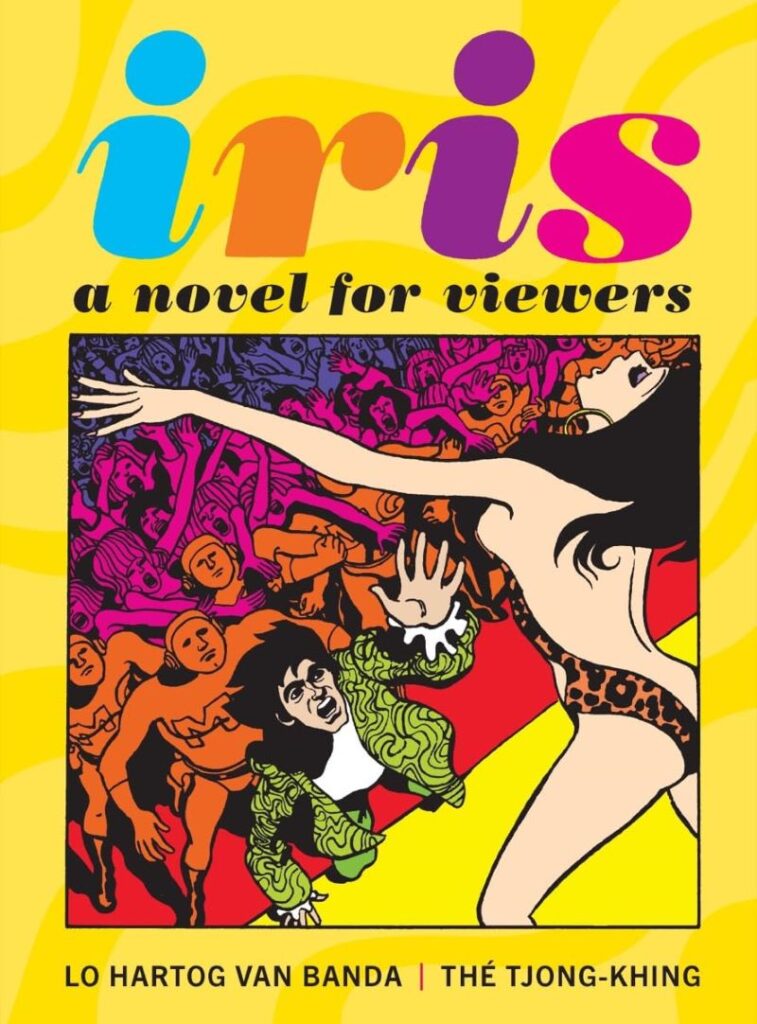
Iris wants to be a pop star. Toiling away at the bottom rungs of the entertainment industry, she seizes a rare chance to audition for a powerful idol maker and finds her life instantly changed when she succeeds. Unfortunately, she quickly learns that life at the top isn’t all she had hoped, leading her to try to escape her stardom with the assistance of her longtime boyfriend, Mark.
Buy Iris: A Novel for ViewersSounds simple enough, but in the talented hands of writer Lo Hartog van Banda and artist Thé Tjong-Khing, her story is a candy-colored, head-spinning trip through a prescient vision of our near future as imagined over 50 years ago. What’s more, the book represents the first-ever Dutch graphic novel, resulting in its explanatory subtitle as the creators struggled to coin a descriptive term for its 1968 debut in their home market.
As Iris becomes further entrapped in her fame, she learns that the idol maker, MG, will stop at nothing to achieve his idealized vision for the consumer masses. We’re left to wonder how far Iris will let MG push her before she abandons her dream, even as counterculture rebels work to get Mark into the highly secretive operation to rescue her. While the white-knight aspect feels a bit stale in an otherwise highly progressive work, the delightfully ambiguous conclusion leaves enough space to debate if MG or Mark truly prevail in the struggle for Iris’s soul.
Banda toys with the era’s generational clash over sexual freedom, setting Iris’s tale against a background where public nudity and free love are commonplace but hair is taboo. Iris establishes the societal mindset in the opening pages when her boyfriend barges into her dressing room, causing her to freak out about how she’s not wearing anything…until she puts on her wig. This is later followed by MG’s bold decision to have Iris grow out her natural hair, further accelerating her fame as a trendsetter and changing the culture as a whole.
Khang’s lovely artwork utilizes broad, chunky brushstrokes and flat planes of vibrant color, seeming like a long-lost relation to Japan’s modern Superflat movement in its bold simplicity. It’s clearly a product of its time, with all the free-love exhibitionism, wild fashions, and dreamy psychedelia one would expect, but his singular vision ensures that it transcends its era and stands as a masterful work of art for all time.
While the actual story is fairly slight at only 90 pages, the new Fantagraphics release incorporates a further 40 pages of fascinating supplemental material detailing the original book’s 1960s production process and reception, its restoration struggle, and its many influences. Some inspirations are evident and likely will have occurred to many readers immediately, chiefly the Pop Art movement, the Beatles film Yellow Submarine, and the risqué French comics Barbarella and The Adventures of Jodelle (also published by Fantagraphics). In fact, Banda references Jodelle as the principal spark that inspired him to write Iris. Other influences may be less obvious, making the supplemental essay a valuable information resource to curious fans interested in tracking down similar works.
Even though the book was first published in 1968, it’s eerie how relevant it is to our present. Banda predicts the manufactured pop star, with MG artificially tweaking Iris’s vocals like Auto-Tune to get his desired sound, and eventually even replacing her physical form with dummy avatars. He also details a “screenless 3D” concert performance decades before holograms, as well as a virtual-reality chamber used to deceive Iris. Most importantly, he tells a compelling and coherent story, and when paired with Khang’s indelible visuals, the result is a fully realized and highly entertaining masterpiece.